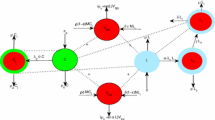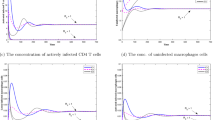Abstract
Since the appearance of HIV, various mathematical models have been proposed to describe the dynamics of the disease. These models are helpful not only to understand the various aspects of disease progression but also help to discover effective drug therapy. In this paper, we have used memetic computing to solve the modified model of HIV dynamics of CD\(4^+\)T cells with the help of differential evolution and Bernstein polynomials. The results of the proposed methodology approach that of the Runge-Kutta method. Furthermore, the stability analysis of the equilibria of this model is also performed. The disease-free equilibrium is found to be unstable within the realistic range of parameters, while the endemic equilibrium could be stable or unstable, depending upon the value of the infection rate.





Similar content being viewed by others
References
Culshaw RV, Ruan S. A delay-differential equation model of HIV infection of CD4(+) T-cells, Mathematical biosciences, 165(1), 27–39.
Gandomani MR, Kajani MT. Numerical Solution of a Fractional Order Model of HIV Infection of CD4+T Cells Using Müntz-Legendre Polynomials, International Journal Bioautomation 20(2) (2016), 193-204.
Huang Y, Rosenkranz SL, Wu H. Modeling HIV dynamics and antiviral response with consideration of time-varying drug exposures, adherence and phenotypic sensitivity, Mathematical biosciences 184(2) (2003), 165-186.
Bortz DM, Nelson PW. Model Selection and Mixed-Effects Modeling of HIV Infection Dynamics, Bulletin of mathematical biology 68(8) (2006), 2005-2025.
Perelson AS, Neumann AU, Markowitz M, Leonard JM, Ho DD. HIV-1 dynamics in vivo: virion clearance rate, infected cell life-span, and viral generation time Science 271(5255) (1996), 1582-1586.
Nowak MA, Bangham CR. Population dynamics of immune responses to persistent viruses, Science 272(5258) (1996), 74-79.
Perelson A, Nelson P. Mathematical Analysis of HIV-1 Dynamics in Vivo, SIAM review 41(1 )(1999), 3-44.
Buratto A, Cesaretto R, Zamarchi R. HIV Inside the Body: A Review of Mathematical Modeling, (2014).
Perelson AS, Kirschner DE, De Boer R. Dynamics of HIV infection of CD4+ T cells, Mathematical biosciences 114(1) (1993), 81-125.
Merrill SJ. AIDS: background and the dynamics of the decline of immunocompetence, Theoretical Immunology, part two. CRC Press, 2018. 59-75.
Merrill SJ. Modeling the Interaction of HIV with Cells of the Immune System, Mathematical and statistical approaches to AIDS epidemiology. Springer, Berlin, Heidelberg, (1989), 371-385.
McLean AR, Kirkwood TBL. A model of human immunodeficiency virus infection in T helper cell clones,Journal of theoretical biology 147(2) (1990), 177-203.
Reibnegger G, Fuchs D, Hausen A, Werner ER, Dierich MP, Wachter H. Theoretical implications of cellular immune reactions against helper lymphocytes infected by an immune system retrovirus, Proceedings of the National Academy of Sciences 84(20) (1987), 7270-7274.
Hraba T, Doležal J. Applications of the Mathematical Model of Immunological Tolerance to Immunoglobulin Suppression and AIDS, Evolution and Control in Biological Systems. Springer, Dordrecht, (1989), 135-142.
Hraba T, Dolezal J. Mathematical model of CD4+ lymphocyte depletion in HIV infection,Folia biologica 35(3) (1989), 156-163.
Bailey JJ, Fletcher JE, Chuck ET, Shrager RI. A kinetic model of CD4+ lymphocytes with the human immunodeficiency virus (HIV), BioSystems 26(3) (1992), 177-183.
Merdan Mehmat Homotopy perturbation method for solving a model for HIV infection of CD4+ T cells, Ístanbul Ticaret Üniversitesi Fen Bilimleri Dergisi 6(12) (2007), 39-52.
Yüzbaşu. A numerical approach to solve the model for HIV infection of CD4+T cells,Applied Mathematical Modelling 36(12) (2012), 5876-5890.
Parand K, Yousefi H, Fotouhifar M, Delkhosh M, Hosseinzadeh M. Shifted Boubaker Lagrangian approach for solving biological systems, International Journal of Biomathematics 11(3) (2018), 1850039.
Ongun MY. The Laplace Adomian Decomposition Method for solving a model for HIV infection of CD4+T cells, Mathematical and Computer Modelling 53(5-6) (2011), 597-603.
Venkatesh SG, Raja Balachandar S, Ayyaswamy SK, Balasubramanian K. A new approach for solving a model for HIV infection of CD4+T-cells arising in mathematical chemistry using wavelets, Journal of Mathematical Chemistry 54(5) (2016), 1072-1082.
El-Baghdady GI, Abbas MM, El-Azab MS, El-Ashwah RM. The Spectral Collocation Method for Solving (HIV-1) via Legendre Polynomials,International Journal of Applied and Computational Mathematics 3(4) (2017), 3333-3340.
Wang L, Li MY. Mathematical analysis of the global dynamics of a model for HIV infection of CD4+ T cells, Mathematical Biosciences 200.1 (2006): 44-57.
Atangana A, Doungmo Goufo EF. Computational Analysis of the Model Describing HIV Infection of CD4+T Cells, BioMed research international 2014 (2014).
Nowak MA, Bonhoeffer S, Shaw GM, May RM. Anti-viral drug treatment: dynamics of resistance in free virus and infected cell populations, Journal of theoretical biology 184(2) (1997), 203-217.
Merdan M, Gökdoğan A, Yildirim A. On the numerical solution of the model for HIV infection of CD4+ T cells, Computers & Mathematics with Applications 62(1) (2011), 118-123.
Storn R, Price K. Differential Evolution – A Simple and Efficient Heuristic for global Optimization over Continuous Spaces, Journal of global optimization 11(4) (1997), 341-359.
Coelho LdS, Mariani VC, Luz MVFd, Leite JV. Novel Gamma Differential Evolution Approach for Multiobjective Transformer Design Optimization, IEEE transactions on magnetics 49(5 )(2013), 2121-2124.
dos Santos Amorim EP, Xavier CR, Campos RS, dos Santos RW. Comparison between Genetic Algorithms and Differential Evolution for Solving the History Matching Problem, International Conference on Computational Science and Its Applications. Springer, Berlin, Heidelberg, (2012).
Bernstein polynomials (Mathematical expositions), American Mathematical Soc., (2013).
Houck CR, Joines JA, Kay MG. Comparison of genetic algorithms, random restart and two-opt switching for solving large location-allocation problems, Computers & Operations Research 23(6) (1996), 587-596.
Houck CR, Joines JA, Kay MG, Wilson JR. Empirical Investigation of the Benefits of Partial Lamarckianism, Evolutionary Computation 5(1) (1997), 31-60.
Boggs PT, Tolle JW. Sequential Quadratic Programming, Acta numerica 4 (1995): 1-51.
Zhao W, Wang L, Yin Y, Wang B, Tang Y. Sequential quadratic programming enhanced backtracking search algorithm, Frontiers of Computer Science 12(2) (2018), 316-330.
Raja MAZ, Asma K, Aslam MS. Bio-inspired computational heuristics to study models of HIV infection of CD4+ T-cell, International Journal of Biomathematics 11(2) (2018), 1850019.
Slotine, J.-J. E and Li, Weiping Applied nonlinear control, Vol. 199. No. 1. Englewood Cliffs, NJ: Prentice hall, (1991).
Yan W, Yi-cang Z. Mathematical Modeling and Dynamics of HIV Progression and Treatment,Chinese Journal of Engineering Mathematics 27(3) (2010), 534-548.
Wang Y, Zhou Y, Wu J, Heffernan J. Oscillatory viral dynamics in a delayed HIV pathogenesis model, Mathematical Biosciences 219(2) (2009), 104-112.
Srivastava PK, Chandra P. Modeling the dynamics of HIV and CD4+ T cells during primary infection, Nonlinear Analysis: Real World Applications 11(2) (2010), 612-618.
Wang X, Song X. Global stability and periodic solution of a model for HIV infection of CD4+ T cells, Applied Mathematics and Computation 189(2) (2007), 1331-1340.
Author information
Authors and Affiliations
Corresponding author
Ethics declarations
Conflict of Interests
There is no conflict of interests regarding the publication of this paper.
Additional information
Communicated by G.D. Veerappa Gowda.
Rights and permissions
About this article
Cite this article
Ahmed, M., Saleem, M.A., Zubair, M. et al. Stability analysis and memetic computation using differential evolution for in-host HIV model. Indian J Pure Appl Math 53, 76–91 (2022). https://doi.org/10.1007/s13226-021-00022-x
Received:
Accepted:
Published:
Issue Date:
DOI: https://doi.org/10.1007/s13226-021-00022-x




